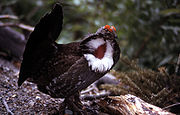Dendragapus
| Dendragapus | |
|---|---|

| |
| Male dusky grouse displaying, Yellowstone NP; note purple air sac and red eye wattle. | |
| Scientific classification | |
| Domain: | Eukaryota |
| Kingdom: | Animalia |
| Phylum: | Chordata |
| Class: | Aves |
| Order: | Galliformes |
| Family: | Phasianidae |
| Tribe: | Tetraonini |
| Genus: | Dendragapus Elliot, 1864 |
| Type species | |
Tetrao obscurus | |
| Species | |
|
Dusky grouse Dendragapus obscurus | |
| Synonyms | |
|
Palaeotetrix | |
The genus Dendragapus contains two closely related species of grouse that have often been treated as a single variable taxon (blue grouse). The two species are the dusky grouse (Dendragapus obscurus) and the sooty grouse (Dendragapus fuliginosus).[1] In addition, the spruce grouse and Siberian grouse have been considered part of this genus.


Description
These are large
Adults have a long square tail, gray at the end (lighter in the sooty grouse). Adult males are mainly dark (especially sooty grouse) with a yellow (sooty grouse) or purplish (dusky grouse)
Their breeding habitat is the edges of conifer and mixed forests in mountainous regions of North America and Eurasia. Their range is closely associated with that of various conifers. The nest is a scrape on the ground concealed under a shrub or log.
All species have healthy populations, except for some population decline and habitat loss of the sooty grouse at the southern end of its range in southern California,[2] and the Siberian grouse which is considered near-threatened.
Species
Extant Species
| Common name | Scientific name and subspecies | Range | Size and ecology | IUCN status and estimated population |
|---|---|---|---|---|
| Dusky grouse | Dendragapus obscurus (Say, 1822) |
the Rocky Mountains in North America
|
Size: Habitat: Diet: |
LC
|
| Sooty grouse | Dendragapus fuliginosus (Ridgway, 1873) |
from southeastern Alaska and Yukon south to California
|
Size: Habitat: Diet: |
LC
|
Fossils
References
- ^ ISSN 0004-8038. Retrieved 2007-09-16.
- ^ ISBN 84-87334-15-6.
- ISBN 978-0-660-19271-0. Archived from the originalon 2007-12-25. Retrieved 2008-05-08.
- ^ ISBN 0-679-45122-6.
- S2CID 20762207. Archived from the original(PDF) on 2007-07-13.
- JSTOR 4075798.




